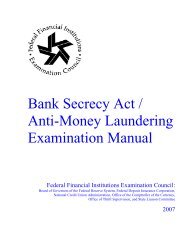Annual Report 2012 - ffiec
Annual Report 2012 - ffiec
Annual Report 2012 - ffiec
Create successful ePaper yourself
Turn your PDF publications into a flip-book with our unique Google optimized e-Paper software.
22<br />
Board of Governors of the<br />
Federal Reserve System<br />
The Federal Reserve Board (FRB)<br />
was established in 1913. It is<br />
headed by a seven-member Board<br />
of Governors; each member is<br />
appointed by the President, with<br />
the advice and consent of the Senate,<br />
for a 14-year term. Subject to<br />
confirmation by the Senate, the<br />
President selects one Board member<br />
to serve a four-year term as<br />
Chairperson and two members to<br />
serve as Vice Chairs; one serves<br />
in the absence of the Chairperson<br />
and the other is designated as Vice<br />
Chair for Supervision. The Chairperson<br />
also serves as a voting<br />
member of the Financial Stability<br />
Oversight Council. One member<br />
of the Board of Governors serves<br />
as the Board’s representative to the<br />
FFIEC. The FRB’s activities most<br />
relevant to the work of the Council<br />
are the following:<br />
• overseeing the quality and efficiency<br />
of the examination and<br />
supervision function of the 12<br />
Federal Reserve Banks;<br />
• developing, issuing, implementing,<br />
and communicating regulations,<br />
supervisory policies, and<br />
guidance, and taking appropriate<br />
enforcement actions applicable<br />
to those organizations that<br />
are within the FRB’s supervisory<br />
oversight authority;<br />
• approving or denying applications<br />
for mergers, acquisitions,<br />
and changes in control by<br />
state member banks and BHCs<br />
(including financial holding<br />
companies (FHCs)); applications<br />
for foreign operations of<br />
member banks and Edge Act<br />
and agreement corporations;<br />
and applications by foreign<br />
banks to establish or acquire<br />
U.S. banks and to establish U.S.<br />
branches, agencies, or representative<br />
offices; and<br />
• supervising and regulating:<br />
— State member banks (i.e.,<br />
state-chartered banks that<br />
are members of the Federal<br />
Reserve System);<br />
— BHCs, including FHCs;<br />
— SLHCs; 1<br />
— Edge Act and agreement<br />
corporations; select nonbank<br />
financial firms;<br />
— International operations<br />
of banking organizations<br />
headquartered in<br />
the United States and the<br />
domestic activities of foreign<br />
banking organizations,<br />
in conjunction with<br />
the responsible licensing<br />
authorities; as well as,<br />
— Nonbank financial firms<br />
designated as systemically<br />
important by the Financial<br />
Stability Oversight Council<br />
(FSOC).<br />
Other supervisory and regulatory<br />
responsibilities of the FRB include<br />
monitoring compliance by entities<br />
under the Board’s jurisdiction<br />
with other statutes (e.g., the<br />
money-laundering provisions of<br />
the Bank Secrecy Act), monitoring<br />
compliance with certain statutes<br />
that protect consumers in credit<br />
and deposit transactions, regulating<br />
margin requirements on securities<br />
transactions, and regulating<br />
transactions between banking<br />
affiliates.<br />
1. The FRB’s role as supervisor of BHCs,<br />
FHCs, and SLHCs is to review and<br />
assess the consolidated organization’s<br />
operations, risk-management systems,<br />
and capital adequacy to ensure that the<br />
holding company and its nonbank subsidiaries<br />
do not threaten the viability<br />
of the company’s depository institutions.<br />
In this role, the FRB serves as the<br />
“umbrella supervisor” of the consolidated<br />
organization. In fulfilling this<br />
role, the FRB relies, to the fullest extent<br />
possible, on information and analysis<br />
provided by the appropriate supervisory<br />
authority of the company’s bank,<br />
securities, or insurance subsidiaries.

















